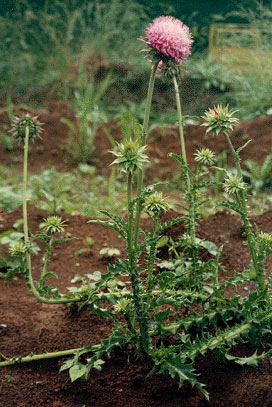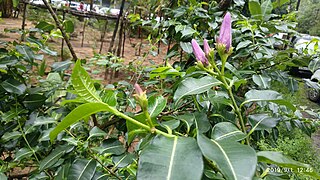
Convolvulaceae, commonly called the bindweeds or morning glories, is a family of about 60 genera and more than 1,650 species. These species are primarily herbaceous vines, but also include trees, shrubs and herbs. The tubers of several species are edible, the best known of which is the sweet potato.

Echium plantagineum, commonly known as purple viper's-bugloss or Patterson's curse, is a species of the genus Echium native to western and southern Europe, northern Africa, and southwestern Asia. It has also been introduced to Australia, South Africa, and United States, where it is an invasive weed. Due to a high concentration of pyrrolizidine alkaloids, it is poisonous to grazing livestock, especially those with simple digestive systems, such as horses.

Carduus nutans, with the common names musk thistle, nodding thistle, and nodding plumeless thistle, is a biennial plant in the daisy and sunflower family Asteraceae. It is native to regions of Eurasia.

Cirsium vulgare, the spear thistle, bull thistle, or common thistle, is a species of the Asteraceae genus Cirsium, native throughout most of Europe, Western Asia, and northwestern Africa. It is also naturalised in North America, Africa, and Australia and is an invasive weed in some areas. It is the national flower of Scotland.

Allium vineale is a perennial, bulb-forming species of wild onion, native to Europe, northwestern Africa and the Middle East. The species was introduced in Australia and North America, where it has become a noxious weed.

Euphorbia heterophylla, also known under the common names of Mexican fireplant, painted euphorbia, Japanese poinsettia, paintedleaf, painted spurge and milkweed, is a plant belonging to the Euphorbiaceae or spurge family.

Parkinsonia aculeata is a species of perennial flowering tree in the pea family, Fabaceae. Common names include palo verde, Mexican palo verde, Parkinsonia, Jerusalem thorn, jelly bean tree, palo de rayo, and retama.

Cryptostegia grandiflora, commonly known as rubber vine, is a woody-perennial vine that is native to south-west Madagascar. It is also a significant weed in northern Australia, sometimes regarded as the worst weed in all of Australia. It has also been introduced to most other tropical and subtropical regions by man, because of its attractive flowers and the fact that its latex contains commercial quality rubber. It is now naturalised in the Caribbean, East Africa, Mauritius, India, Southeast Asia, Indonesia, Latin America, the southern United States, Fiji and New Caledonia. It is very similar to the purple rubber vine, which is also native to Madagascar.

Ipomoea alba, sometimes called the tropical white morning-glory or moonflower or moon vine, is a species of night-blooming morning glory, native to tropical and subtropical regions of North and South America, from Argentina to northern Mexico, Arizona, Florida and the West Indies. Though formerly classified as genus Calonyction, species aculeatum, it is now properly assigned to genus Ipomoea, subgenus Quamoclit, section Calonyction.

Anredera cordifolia, commonly known as the Madeira vine or mignonette vine, is a South American species of ornamental succulent vine of the family Basellaceae. The combination of fleshy leaves and thick aerial tubers makes this a very heavy vine. It smothers trees and other vegetation it grows on and can easily break branches and bring down entire trees on its own. Other names include lamb's tail and potato vine.

Ipomoea cairica is a vining, herbaceous, perennial plant with palmate leaves and large, showy white to lavender flowers. A species of morning glory, it has many common names, including mile-a-minute vine, Messina creeper, Cairo morning glory, coast morning glory and railroad creeper. The species name cairica translates to "from Cairo", the city where this species was first collected.

Mimosa pigra, commonly known as the giant sensitive tree, is a species of plant of the genus Mimosa, in the family Fabaceae.

Asparagus asparagoides, commonly known as bridal creeper, bridal-veil creeper, gnarboola, smilax or smilax asparagus, is a herbaceous climbing plant of the family Asparagaceae native to eastern and southern Africa. Sometimes grown as an ornamental plant, it has become a serious environmental weed in Australia and New Zealand.

Tecoma stans is a species of flowering perennial shrub in the trumpet vine family, Bignoniaceae, that is native to the Americas. Common names include yellow trumpetbush, yellow bells, yellow elder, ginger Thomas. Tecoma stans is the official flower of the United States Virgin Islands and the floral emblem of The Bahamas.

Opuntia stricta is a species of large cactus that is endemic to the subtropical and tropical coastal areas of the Americas, especially around the Caribbean. Common names include erect prickly pear and nopal estricto (Spanish). The first description as Cactus strictus was published in 1803 by Adrian Hardy Haworth. In 1812 he moved the species to the genus Opuntia.

Macroptilium atropurpureum, commonly referred to as purple bush-bean, or siratro is a perennial legume recognized by its climbing, dense, green vines and deep purple flowers. The plant is indigenous to the tropical and subtropical regions of North, Central, and South America, as far north as Texas in the USA and as far south as Peru and Brazil. It has been introduced for use as a food for stock to many tropical regions around the world. It has become an invasive pest plant in a number of areas, including the north-eastern coast of Australia. Rich in protein, M. atropurpureum is commonly used for cattle pastures intercropped with grass, used in hay, or as a ground cover to prevent soil erosion and to improve soil quality.

Passiflora suberosa is a species of passionflower that is native to the Americas. It is commonly known as corkystem passionflower due to the corkiness of older stems. Other common names include corky passion vine, cork-bark passion flower, corkstem passionflower and corky passionfruit. In Latin America it is called Meloncillo. It is possibly also cryptic and have multiple species in one.

Thunbergia grandiflora is an evergreen vine in the family Acanthaceae. It is native to China, India, Nepal, Bangladesh, Indochina and Myanmar and widely naturalised elsewhere. Common names include Bengal clockvine, Bengal trumpet, blue skyflower, blue thunbergia, blue trumpetvine, clockvine, skyflower and skyvine.

Cardiospermum grandiflorum, commonly known as showy balloonvine, heart pea or heart seed, is a species of climbing plant native to eastern Argentina and Brazil.

Cryptostegia madagascariensis is a species of flowering plant in the family Apocynaceae. It is commonly known as purple rubber vine, is a woody-perennial vine that is native to western and northern Madagascar. It has also been introduced to several tropical and subtropical regions by man, including Puerto Rico and the Virgin Islands. It is very similar to the rubber vine, which is also native to Madagascar. In their area of overlap some hybrids have been observed, which are distinguishable by intermediate flower morphology. In the 1930s a hybrid was also developed for horticultural purposes.

























